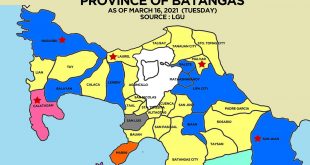Visit the Sto. Tomas, Batangas page for all information on Sto. Tomas.
What you are about to read is the history of Sto. Tomas.
Sto. Tomas, one of the oldest town of Batangas, is located at the foot of the legendary and picturesque Mt. Makiling. It is sixty (60) kilometers south of Manila and known as the birthplace of Gen. Miguel Malvar, the last Filipino general to surrender to the American.
The town of Sto. Tomas was actually founded in 1666, with Captain Maniel Melo as its first head. Originally, it was composed of a large Poblacion. When the Spanish friars arrived their first and foremost objective was to construct a church near the river to satisfy their propensity for water. Thus the present site of the Roman Catholic Church was chosen, just as a stone’s throw from the San Juan River. As years went by, more and more houses were built around the church. This became the center of the Poblacion.
Other groups of houses were scattered all over the area. They were given such odd names as “Kabaong”, because the stones along the road were coffin shaped; “Putol” because the trail was cut short by the Makiling Mountain, “Aptayin”, because “apta” of fine shrimps were found in the brook, “Biga” because Biga Trees abounded there, and “Camballao”, because twin rivers divided the place. These different unit groups comprised the barrios of the town.
The natives were by nature God-fearing, peaceful and obedient. The conquerors did not much have difficulty in enforcing decrees and orders. One suc irrevocable decree was to change the original names of the barrios to the names of Saints in the Catholic Calendar and to place each of them under its patrotonio, the former “pook” and “Aptayin” were joined together and called San Bartolome, “Kabaong” was change to San Vicente, “Biga” to Sta. Anastacia, and “Camballao” to San Isidro Sur and Isidro Norte. The whole town was given the name of Sto. Tomas de Aquino, a high Prince of the Dominican Order to where most of the first friars belonged. As time went by, more and more barrios were added to the list. Each with an assumed name of a saint. This unchanged set-up makes Sto. Tomas the most unique not only in Batangas but all over the Philippines.
At present, it has thirty barrios namely: Sta. Anastacia, San Rafael, Santiago, San Antonio, San Bartolome, San Miguel, San Roque, San Pedro, San Pablo, San Felix, San Jose, San Juan, San Agustin, Sta. Ana, San Joaquin, San Fernando, Sta. Clara, San Luis, Sta. Cruz, San Isidro Sur, San Isidro Norte, San Francisco, Sta. Maria, Sta. Elena, Sta. Teresita, Poblacion I, Poblacion II, Poblacion III, Poblacion IV.
From the year 1666, the head of the town had different titles. He was variously known as “Captain” from 1666 to 1782l; “Alcalde” from 1783 to 1788; “Gobernadorcillo” from 1789 to 1821; “Presidente Local” from 1822 to 1899; “Presidente Municipal” from 1900 to 1930; and “Municipal Mayor” from 1931 to the present.
Last Updated: October 4, 2013
 WOWBatangas.com Your Source of Great News and Stories from the Province of Batangas, Philippines
WOWBatangas.com Your Source of Great News and Stories from the Province of Batangas, Philippines



